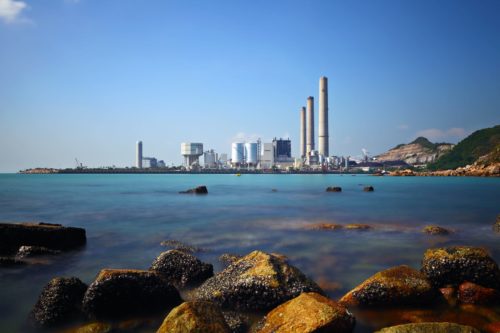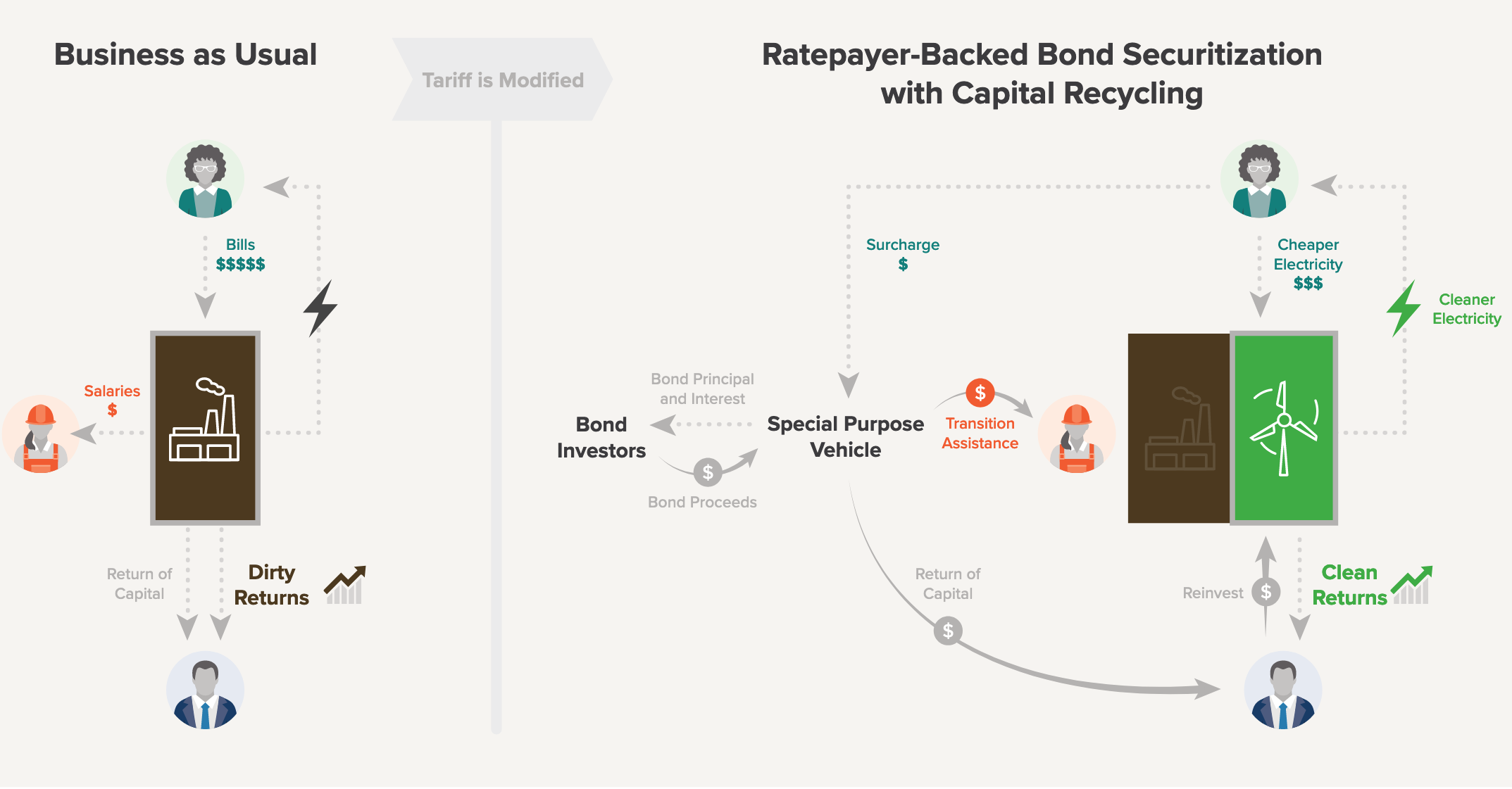Coal fired power plant

Securitization in Action: How US States Are Shaping an Equitable Coal Transition
Much has been made of coal’s dramatic decline. Coal is no longer the cheapest way to generate electricity in many countries, and in recent years power plants and mines have closed in the face of this economic reality, especially in the United States and Europe. In the coming decade, as the economics of coal power continue to erode and urgency grows to mitigate coal’s significant climate and public health burdens, many more plants and mines will retire.
Although coal phaseout will create significant societal benefits, current coal customers, workers, and communities face important near-term risks and costs in the transition. Electricity customers all over the world are locked into paying utilities or other power suppliers based on long-term contracts or cost-of-service tariffs, which are in place for 93 percent of coal capacity. Replacing coal with clean energy can create a price spike for customers if they are required to pay for the new clean assets on top of their existing coal contract or tariff. Phaseout can present an existential threat for displaced coal workers who lack a robust social safety net and for communities dependent on taxes from coal businesses to fund basic services.
The 2020 report How to Retire Early outlined a three-part approach to mitigate these challenges: refinancing existing coal obligations, reinvesting in clean energy, and funding transition assistance. Subnational governments have begun deploying innovative financing tools that align with the three-part approach. Over the past year, utilities in three US states have received approval to deploy ratepayer-backed bonds, commonly known as securitization, to mitigate the near-term impacts of coal plant retirements. More states are moving quickly to capitalize on this momentum by creating legislation necessary to enable the use of securitization. These recent experiences can provide practical lessons for governments and other stakeholders around the world as they explore ways to equitably transition to clean energy.
A Brief Introduction to Securitization
Securitization is a financing tool that creates the possibility for a rare win-win-win: as a coal plant retires, consumers pay lower electricity rates, utilities invest in and benefit from clean energy replacement, and workers and communities receive funding to support local economic development.
Utilities have used securitization for decades to lower customer costs for unanticipated expenses, and recently the tool has been applied to support coal phaseout. In the context of coal retirement, securitization is akin to refinancing a mortgage. The rates paid by customers of investor-owned utilities in the United States include charges to allow utility investors the opportunity to earn a fair return (on an after-tax basis) on their invested capital. Since utility capital is usually an even mix of debt and equity, this translates into an effective “interest rate” (analogous to that of a mortgage) of 8–10 percent. Securitization replaces this rate of return with a low-interest-rate bond (of about 2–4 percent) that is paid back over a long period of time.
By refinancing the existing customer obligation to pay the utility’s return on equity and debt with just low-cost debt, securitization creates immediate and long-term savings for ratepayers. A portion of these savings can be reinvested into transition assistance to help workers and communities prosper in a decarbonized economy, and utilities can reinvest their capital in cheaper clean energy assets. Importantly, states must pass legislation to ensure that bonds receive a high rating, which maximizes savings for customers.
Securitization in Action
In the past six months, Wisconsin, Michigan, and New Mexico have authorized utilities to use securitization to mitigate the impacts of coal plant retirement. More states, including Colorado, have recently passed or are considering enabling legislation.
Building on Wisconsin’s Securitization
We Energies retired its Pleasant Prairie coal plant in southern Wisconsin in 2018, but the question remained of how to pay for unrecovered costs. Initially, the utility proposed holding customers responsible for paying off the remaining costs through rates. However, in November 2020, We Energies agreed to a settlement to securitize $100 million of those costs, which will save customers $40 million over the next 15 years.
The deal was a success for customers, but savings were limited by Wisconsin’s law, which allows securitization only for pollution-control investments, not the full cost of a plant. Governor Tony Evers has proposed expanding the state’s law to include the broader costs of coal retirement, and future legislation could include provisions to assist communities and workers in the transition.
Stakeholder Intervention in Michigan
In December 2020 the Michigan Public Service Commission approved Consumers Energy’s proposal to use $688 million in securitized bonds to retire the D. E. Karn coal plant—a plan that will save customers $124 million. The proposal resulted from a robust stakeholder process. Consumers Energy’s first plan to retire Karn, which it proposed in 2018, held ratepayers responsible for paying off the remaining costs even after plant retirement. Environmental and consumer groups intervened, and the parties reached a settlement that uses securitization to reduce the cost of closing the plant and the amount paid by customers. The settlement requires the utility to submit an analysis on retiring additional coal plants, providing Consumers an opportunity to retire additional coal with securitization in the future.
Michigan’s securitization statute does not include measures for transition assistance or replacement resources; however, Consumers has committed to procuring new clean energy and ensuring its workers are not left behind. Consumers’ most recent resource plan commits to a 90 percent reduction in carbon emissions by 2040 and to 6 GW of new solar energy by 2030, including 1.2 GW of solar that will be installed by the end of 2021—half of which will be utility owned. Consumers also pledged to train and transition current employees to new positions, and to redevelop coal sites for future uses that benefit local communities.
Renewable Energy and Transition Funding in New Mexico
New Mexico’s 2019 Energy Transition Act (ETA) enabled the use of securitization and paved the way for renewable energy replacement and a robust transition assistance package. In April 2020, Public Service of New Mexico (PNM) received approval to issue $360 million in ratepayer-backed bonds to mitigate the impacts of retiring the coal-fired San Juan Generating Station (SJGS). Using securitization to close the plant and investing in renewable replacement resources will save PNM’s customers nearly $80 million in 2023 alone, with the average residential customer saving $6.87 per month.
The ETA specifies that replacement resources must be assessed for their environmental impact and benefit to local communities. While none of the approved replacement resources will be owned by PNM, the portfolio consists entirely of zero-carbon resources. Furthermore, two solar and battery storage projects totaling $447 million in capital investments will be built in the school district that hosted SJGS, providing jobs and property taxes to partially offset the loss of SJGS. An additional $430 million in other solar and battery storage projects will be built in nearby counties.
The ETA also specifies that a portion of the bond proceeds must be set aside for transition assistance. The SJGS bond will provide $20 million to fund job training and severance for plant employees, and another $19.8 million will be directed to worker assistance, economic development, and tribal communities.
Colorado’s Securitization Legislation: A Template for Three-Part Approach
Securitization has not yet been used by utilities in Colorado, but the legislation serves as a model to unlock the three-part approach outlined in How to Retire Early. Colorado first introduced securitization legislation in 2017, and legislators worked closely with union representatives to draft strong provisions for transition assistance. After extensive engagement with labor, community, and utility stakeholders, the law passed in 2019.
In addition to enabling securitization, Colorado’s law provides strong consumer protections: the Colorado Public Utilities Commission has a strict mandate to maximize benefits and minimize risks for ratepayers. And unlike in New Mexico, the commission holds broad authority to oversee the details of how the utility structures and funds its bonds. The bill also provides protections for affected communities by requiring utilities to fund already approved local government or school district projects. Finally, utilities can own up to 50 percent of the clean energy resources they procure, providing the ability to reinvest capital into renewable energy.
Other states are moving quickly to capitalize on this momentum. Montana passed legislation in 2019 to enable securitization; in 2021, bills have been introduced in Indiana, Kansas, Missouri, and Minnesota. Interest from utilities, environmental groups, and other stakeholders continues to grow.
Conclusion
In this time of global economic distress, customers worldwide are paying more for electricity from expensive coal when they can least afford to—coal that is at the same time creating significant climate and public health burdens. Securitization offers a pathway to realize the three-part approach to equitable coal retirement.
Governments all over the world urgently need financial mechanisms that can mitigate the impacts of coal retirement. Wisconsin, Michigan, New Mexico, and Colorado offer case studies that governments can use to identify best practices for structuring legislation and engaging stakeholders to create a win-win-win for customers, asset owners, and workers and communities. The experiences from US states can inform the future use of securitization to enable a rapid and equitable coal transition.
